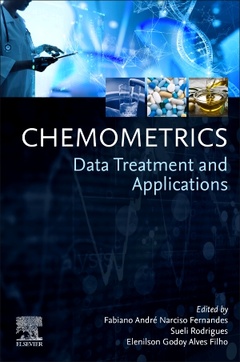Description
Chemometrics
Data Treatment and Applications
Coordinators: Fernandes Fabiano André Narciso, Rodrigues Sueli, Filho Elenilson Godoy Alves
Language: English
Subjects for Chemometrics:
470 p. · 15x22.8 cm · Paperback
Description
/li>Contents
/li>Biography
/li>Comment
/li>
Chemometrics: Data Treatment and Applications demonstrates best practices for treating real-world analytical instrument data and how to apply chemometrics to this data. Rather than focusing on the mathematical theory involved in chemometrics, the book is meant for the industrial chemist, academics, and advanced students that want to use chemometrics in practice. Case studies on several applications are presented. Unlike existing literature, this book focuses on best practices, practical realities, and challenges when treating data, rather than on the mathematical theory. It also provides basic information on chemometrics and the best practices used to treat data from different analytical instruments. The book is written primarily for analytic chemists as practitioners in analytical laboratories and other industries. It will also be useful to academics and graduate, masters and postdoc students chiefly working in analytical chemistry who want to improve the practical aspects of their research activities.
1. Introduction
2. Relevant topics in the Interpretation of Chemometric Data
3. Experimental design for chemometrics. Best practices
4. Chemometric Basis for Artificial Intelligence, Machine Learning, and Data Mining
5. Hyperspectral imaging combined with chemometrics
SECTION 2 – CHEMICAL ANALYSIS APPROACHES
6. E-nose, and E-tongue combined with chemometrics
7. NIR and FTIR Spectrometry combined with chemometrics
8. NMR combined with chemometrics
9. Olfactometry combined with chemometrics
10. One- and two-dimensional chromatography combined with chemometrics
11. Raman spectroscopy combined with chemometrics
12. Sensors and chemometrics
SECTION 3 – Applications
14. Food Adulteration
15. Forensics
16. Geographical origin identification and authentication
17. Heavy Metals
18. Metabolite Identification
19. Pharmaceuticals
20. Water Pollution and contaminants
21. Soils Mapping
22. Clinical Diagnostics
Sueli Rodrigues is a Professor at the Department of Food Science and Technology, Universidade Federal do Ceará, Brazil. She graduated in Chemical Engineering from Universidade Estadual de Campinas (1998), completing a Master's in Chemical Engineering from Universidade Estadual de Campinas in 2000 and a PhD inChemical Engineering from Universidade Estadual de Campinas (2003).
Elenilson Godoy Alves Filho is currently Professor at the Food Engineering Department in UFC-Fortaleza, Brazil. He
developed his undergraduate research in GC-MS and analytical chemistry at the Federal University of Ceara (UFC), Brazil, where he was organic chemistry monitor. His master's degree was carried out in UFC applied to quantification and chemometric by NMR. He developed his PhD research in UFSCar applied to qNMR, chemometrics, as well as a PhD at University of Toronto applied to HPLC-(UV/MS)-SPE-ASS-NMR and CMP-NMR probe analyses. He developed his Postdoc in food research by qNMR, GC-MS, and LC-MS, all coupled to chemometrics.
- Presents topical and important chapters for the most-used analytical instruments
- Focuses on practical issues in the implementation of chemometrics
- Examines advances in the application of chemometrics in several fields
- Includes frank perspectives on what works well for the data of a certain analytical instrument given the multiple choices of mathematical models and protocols that can be applied
- Covered protocols are heavily illustrated with case studies showing their potential use and the advances in chemometrics
These books may interest you

Chemometrics in Excel 98.99 €



